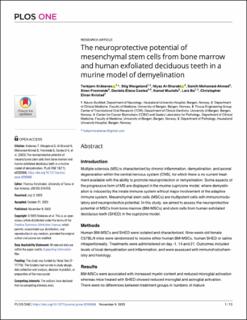| dc.contributor.author | Kråkenes, Torbjørn | |
| dc.contributor.author | Wergeland, Stig | |
| dc.contributor.author | Al-Sharabi, Niyaz Abdulbaqi Abdulmajid | |
| dc.contributor.author | Mohamed-Ahmed, Samih Salah Eldin Mahgoub | |
| dc.contributor.author | Fromreide, Siren | |
| dc.contributor.author | Costea, Daniela Elena | |
| dc.contributor.author | Mustafa, Kamal Babikeir Elnour | |
| dc.contributor.author | Bø, Lars | |
| dc.contributor.author | Kvistad, Christopher Elnan | |
| dc.date.accessioned | 2024-01-29T14:05:23Z | |
| dc.date.available | 2024-01-29T14:05:23Z | |
| dc.date.created | 2023-11-28T10:59:07Z | |
| dc.date.issued | 2023 | |
| dc.identifier.issn | 1932-6203 | |
| dc.identifier.uri | https://hdl.handle.net/11250/3114351 | |
| dc.description.abstract | Introduction
Multiple sclerosis (MS) is characterized by chronic inflammation, demyelination, and axonal degeneration within the central nervous system (CNS), for which there is no current treatment available with the ability to promote neuroprotection or remyelination. Some aspects of the progressive form of MS are displayed in the murine cuprizone model, where demyelination is induced by the innate immune system without major involvement of the adaptive immune system. Mesenchymal stem cells (MSCs) are multipotent cells with immunomodulatory and neuroprotective potential. In this study, we aimed to assess the neuroprotective potential of MSCs from bone marrow (BM-MSCs) and stem cells from human exfoliated deciduous teeth (SHED) in the cuprizone model.
Methods
Human BM-MSCs and SHED were isolated and characterized. Nine-week-old female C57BL/6 mice were randomized to receive either human BM-MSCs, human SHED or saline intraperitoneally. Treatments were administered on day -1, 14 and 21. Outcomes included levels of local demyelination and inflammation, and were assessed with immunohistochemistry and histology.
Results
BM-MSCs were associated with increased myelin content and reduced microglial activation whereas mice treated with SHED showed reduced microglial and astroglial activation. There were no differences between treatment groups in numbers of mature oligodendrocytes or axonal injury. MSCs were identified in the demyelinated corpus callosum in 40% of the cuprizone mice in both the BM-MSC and SHED group.
Conclusion
Our results suggest a neuroprotective effect of MSCs in a toxic MS model, with demyelination mediated by the innate immune system. | en_US |
| dc.language.iso | eng | en_US |
| dc.publisher | PLoS | en_US |
| dc.rights | Navngivelse 4.0 Internasjonal | * |
| dc.rights.uri | http://creativecommons.org/licenses/by/4.0/deed.no | * |
| dc.title | The neuroprotective potential of mesenchymal stem cells from bone marrow and human exfoliated deciduous teeth in a murine model of demyelination | en_US |
| dc.type | Journal article | en_US |
| dc.type | Peer reviewed | en_US |
| dc.description.version | publishedVersion | en_US |
| dc.rights.holder | Copyright 2023 The Author(s) | en_US |
| dc.source.articlenumber | e0293908 | en_US |
| cristin.ispublished | true | |
| cristin.fulltext | original | |
| cristin.qualitycode | 1 | |
| dc.identifier.doi | 10.1371/journal.pone.0293908 | |
| dc.identifier.cristin | 2203565 | |
| dc.source.journal | PLOS ONE | en_US |
| dc.identifier.citation | PLOS ONE. 2023, 18 (11), e0293908. | en_US |
| dc.source.volume | 18 | en_US |
| dc.source.issue | 11 | en_US |

